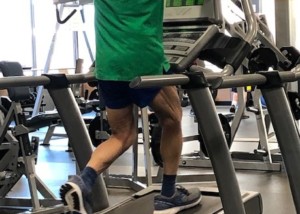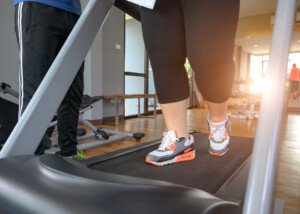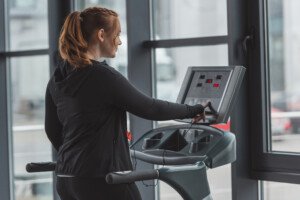
If you hold onto the treadmill while using the incline, you’re burning far fewer calories than what the display says.
Holding on cancels out the incline and causes many other problems.
Why do you use the incline?
Is it to burn more calories? Do you think you’re burning more calories because the higher the incline, more calories show on the readout?
Calorie Burning Facts for the Treadmill Incline
• The calorie readout is determined only by the motor speed and incline, and this computer-generated number is the same whether a professional football player is on the machine without holding on, or someone’s sweet little grandmother is on the machine gripping for dear life.
• The reality, of course, is that anyone who’s not holding on will burn far more calories than someone whose hands are glued to the machine.
• Holding on burns 20-25 percent fewer calories, and the calorie counter will not show this.
• The calorie readout on the treadmill will show the same number at 15 percent incline and 4 mph even if NOBODY is on the machine and the motor is just left running by itself.
• The machine has no way of “knowing” what kind of metabolism the user has, and thus, the calorie computation is based on a generic formula that’s triggered by the given speed and incline.
So if you think you burned 540 calories after yanking your hands on the front bar or console for an hour at 15 percent incline, you are extremely mistaken.
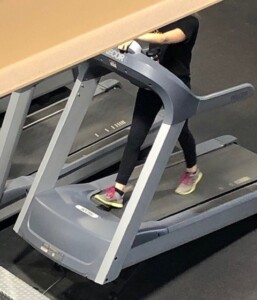
Make Believe Incline Walking
You may feel that, after a whole hour, even holding on, that you got in a good workout. But you didn’t.
You subjected your hips to ballistic motion because they were forced to over-rotate, since your upper body was frozen in place. This could strain hip muscles.
You subtracted workload from your core and back muscles, because the bones in your arms supported you as you held on.
Your feet, ankles and lower legs failed to get an efficient workout because the bones in your arms did much of the work.
How do bones do the work when holding onto a treadmill?
• Here’s a good way to understand how this works. First of all, bones are stronger than muscle.
• You can prove this by picking up a heavy suitcase on either side of your body and walking around, carrying this heavy luggage.
• Are your arms straight or bent? You know they’re straight, as straight as a pin.
• Now continue walking around but bend your arms to the point of between 90 degrees and straight (about 135 degrees).
This flexion of your elbows makes the carrying significantly more difficult. Why?
Because you’ve transferred the weight to your muscles, whereas when your arms were pin-straight, the bones were absorbing most of the weight.
Another way to look at this is to hang from a pull-up bar, feet off the floor, arms pin-straight.
This will be easy for 10 seconds, depending on your fitness level. Now pull yourself up. What happens?
CAN you even pull yourself up to a 135 degree arm bend?
Now granted, some people who can knock off pull-ups do hold onto a treadmill when using the incline, and if you’re one of these people, you still have to admit that just hanging straight-armed is a LOT easier than knocking off your pull-ups.
That’s because bones are stronger than muscle, and when you hang straight armed vs. bent armed, your bones take much of the work.
This same principle applies to holding onto a treadmill at an incline with straight arms, body leaning back.
The bones in your arms act as anchoring rods, taking work away from your back, core and legs.
If you bend your arms, while holding on, to prevent your body from tilting back at the same angle of the incline, you are still burning far fewer calories.
This maneuver does not correct the problem.
• By leaning forward with bent arms, you are now tugging at the front bar with each step.
• The bones in your arms are still absorbing quite a bit of resistance, though the more you bend, the more work that the muscles in your ARMS do—while your core and legs get a free pass.
Ever notice that senior age people can walk on a high incline holding on as well as 20-somethings?
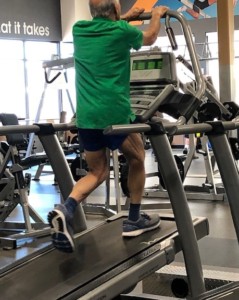
That’s because locking the hands on the front bar, arms straight and leaning back, is quite easy to do.
And the calorie readout is greatly inflated.
Maximize Calories Burned on Treadmill Incline
• Hands off. Don’t use the side rails, either. The extra work that the bones and muscles in your arms do when holding on still burns far fewer calories than if you let go.
• Use a realistic incline for the speed, or a realistic speed for the incline.
• A realistic speed for 15 percent sustained is 1 to 2 mph for most people. This is the same speed many people would walk if outdoors on a 15 percent mountain trail.
• If 2 mph is too slow for you, try 2.5 mph or 3 (which is pretty stiff for sustained walking). Just don’t hold on, period.
• Never mind the calorie display. Do you feel like you’re kicking butt?
To further maximize the calorie burn of using a treadmill incline, apply a technique called high intensity interval training. People of all fitness levels and sizes can do this.
 Lorra Garrick is a former personal trainer certified through the American Council on Exercise. At Bally Total Fitness she trained women and men of all ages for fat loss, muscle building, fitness and improved health.
Lorra Garrick is a former personal trainer certified through the American Council on Exercise. At Bally Total Fitness she trained women and men of all ages for fat loss, muscle building, fitness and improved health.
.


